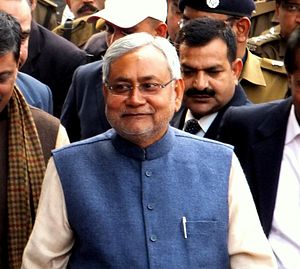The rise of Narendra Modi and the Bharatiya Janata Party(BJP) in the recently held general elections of May 2014 have led to a push for new realignments among local political forces in northern and eastern India. Many regional parties that have hitherto been bitter rivals are contemplating forming political alliances to stall the BJP. Many of these regional parties are based on caste voting blocs. Can alliances of caste interests challenge Modi’s ideology which purports to represent the developmental aspirations of a new generation cutting across caste lines?
Taking the lead in forming the so-called “secular alliance” are two former chief ministers of Bihar state, Nitish Kumar and Laloo Prasad Yadav, the leaders of two local parties: the Janata Dal (United) or JD (U) and Rashtriya Janata Dal (RJD) respectively. The two men were bitter rivals for decades before suddenly becoming friendly again after the May 2014 elections. Based on how this alliance turns out, it could serve as an inspiration for a similar realignment in the larger northern state of Uttar Pradesh.
Both Kumar and Yadav ruled Bihar over the past two decades, after coming to power on the platform of helping the poor. Both leaders failed to live up to their promises and their regimes inevitable devolved into cronyism and corruption. Perhaps because they were tired of this political merry-go-round, Biharis voted overwhelmingly for the BJP in this year’s parliamentary election. The ruling JD (U) and the RJP, which was in an alliance with the Indian National Congress, lost out overwhelmingly to the BJP and its allies.
As a result of this impressive victory by the BJP, the regional parties of Bihar have calculated that perhaps an alliance between them would stall the BJP’s momentum. While the JD (U) and RJD combined received 44 percent of the popular vote in the May 2014 election, the BJP and its allies got 35 percent of the vote. In theory, a combined regional alliance should be able to win more seats than the BJP. This theory will be tested on August 21 when legislative assembly bi-elections will be held in Bihar. The two regional parties and the Congress are all contesting the elections together against the BJP.
However, most political analysts believe that the alliance is unstable. Alliances between parties with different goals, leaders, and vote-banks are unlikely to work in the long run. Laloo Prasad Yadav, the leader of this new alliance also has an unsavory and corrupt reputation. While his ascent to power in Bihar in 1989 broke the monopoly of upper-caste rule in the state, it ushered in an era of lawlessness and chaos in the state. No economic development occurred and Bihar was left far behind other states in terms of development. Nitish Kumar turned out to be somewhat better. His party came to power in 2005 in alliance with the BJP and improved the economic prospects of the state. However, vote-bank politics tempted him and last year he broke with the BJP in an attempt to consolidate Muslim and extreme backward caste (EBC) constituencies. This strategy dramatically backfired in the May 2014 election and Kumar resigned as chief minister. He was succeeded by Jitan Manjhi, also from the JD (U).
The alliance between the two parties is suffering from serious image problems because of Yadav’s reputation and the fact that everyone knows it is an alliance of convenience with no underlying principles. However, some of its supporters believe that it might be successful if it is marketed as a Muslim and low-caste alliance against high-caste Hindus, who generally vote for the BJP.
It should be noted, however, that many low-caste Hindus voted for the BJP in the May 2014 election. Modi’s popularity and policies broke through caste barriers and the BJP received support from a cross section of society. The BJP under Modi has employed new language, techniques, and slogans to reach out to voters outside its traditional Hindu-nationalist base while the regional parties of Bihar have remained stuck with old strategies that do no transcend their traditional constituencies.
The success of the “secular alliance” in Bihar will be a test of the BJP’s appeal and strength as well as the policy of making makeshift alliances to counter popular national parties. If the alliance fails, it will confirm the success of Modi’s strategy. However, if the alliance does well, it might cast some doubt on the long term success of the BJP and lead to similar realignments in other states, primarily Uttar Pradesh. The BJP won 73 out of 80 parliamentary seats in Uttar Pradesh in May 2014, essentially wiping out the local parties: the Bahujan Samajwadi Party (BSP) and Samajwadi Party (SP). The BJP is also looking into making inroads into the states of West Bengal and Jammu and Kashmir, in both local state elections and in national elections.
The rise of the BJP has disrupted India’s slide into a political system dominated by local parties. What remains to be seen is if this reversal is permanent or temporary.

































